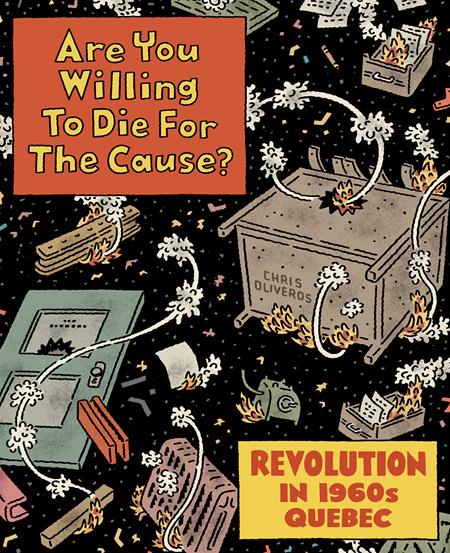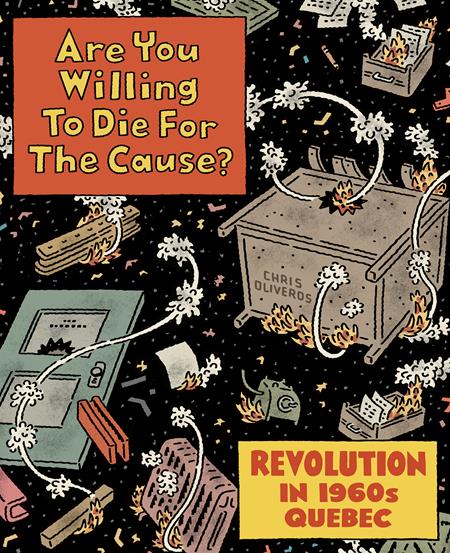Drawn & Quarterly
ARE YOU WILLING TO DIE FOR THE CAUSE
ARE YOU WILLING TO DIE FOR THE CAUSE
Couldn't load pickup availability

Collapsible content
ABOUT
A deep dive into a contentious and dramatic period in Canadian history—the rise of a militant separatist group whose effects still reverberate today.It started in 1963, when a dozen mailboxes in a wealthy Montreal neighborhood were blown to bits by handmade bombs. By the following year, a guerrilla army camp was set up deep in the woods, with would-be soldiers training for armed revolt. Then, in 1966, two high-school students dropped off bombs at factories, causing fatalities. What was behind these concerted, often bungled acts of terrorism, and how did they last for nearly eight years?In Are You Willing to Die for the Cause?, Quebec-born cartoonist Chris Oliveros sets out to dispel common misconceptions about the birth and early years of a movement that, while now defunct, still holds a tight grip on the hearts and minds of Quebec citizenry and Canadian politics. There are no initials more volatile in Quebec history than FLQ—the Front de libération du Québec (or, in English, the Quebec Liberation Front). The original goal of this socialist movement was to fight for workers' rights of the French majority who found their rights trampled on by English bosses. The goal became ridding the province of its English oppression by means of violent revolution.Using dozens of obscure and long-forgotten sources, Oliveros skillfully weaves a comics oral history where the activists, employers, politicians, and secretaries piece together the sequence of events. At times humorous, other times dramatic, and always informative, Are You Willing to Die for the Cause? shines a light on just how little it takes to organize dissent and who people trust to overthrow the government.
PRE-ORDER
Secure the best deal by acting fast! Our Pre-Order promo offers unbeatable prices on must-have items. Be quick to lock in the lowest cost before the promo ends.
The best part? You won't be charged until your item is ready to ship. This means you can reserve your product at the best price without immediate payment. Whether you're first in line or just ahead of the crowd, you're making a smart choice. Reserve your item now and enjoy the benefits of being an early buyer, with the added flexibility of delayed payment!
STANDARD, PRIMARY, DM AND VARIANT COVERS
Standard and Primary covers are widely available through general retailers. They often have higher print runs and can be cheaper, especially during sales.
In contrast, Direct Market (DM) and variant covers are primarily sold in comic shops. DM editions tend to have more limited availability and may be more valuable to collectors.
The main differences lie in artwork style, availability, price, and collector appeal. Ultimately, the choice between standard and variant covers depends on personal preference, budget, and individual collecting goals.
PRODUCT TYPES
Comic book enthusiasts have various formats to choose from when collecting their favorite stories.
Here's a brief overview of the main types:
Omnibus
- Large, hardcover collections
- Usually contain complete runs or extensive story arcs
- Typically 800-1000+ pages
- Higher price point, often €100-€150
Oversized Hardcover (OHC)
- Similar dimensions to omnibus, but thinner
- Collect shorter runs or story arcs
- Usually 300-600 pages
- Priced between €30-€50
Hardcover (HC)
- Standard-sized hardcover books
- Collect 6-12 issues typically
- Similar dimensions to single issues, but with a hard cover
- Priced around €25-€35
Trade Paperback (TP)
- Softcover collections
- Standard comic book size
- Usually collect 4-6 issues
- Most affordable option, typically €15-€25
Other Formats
- Absolute Editions: Oversized, deluxe hardcovers (mainly DC Comics)
- Compendiums: Massive paperback collections
- Graphic Novels (OGN/GN): Original stories not previously released as single issues
The choice between these formats often depends on personal preference, budget, and collecting goals. Omnibus and OHC editions offer larger artwork and more content but at a higher price, while TPs provide a more affordable way to collect complete story arcs

